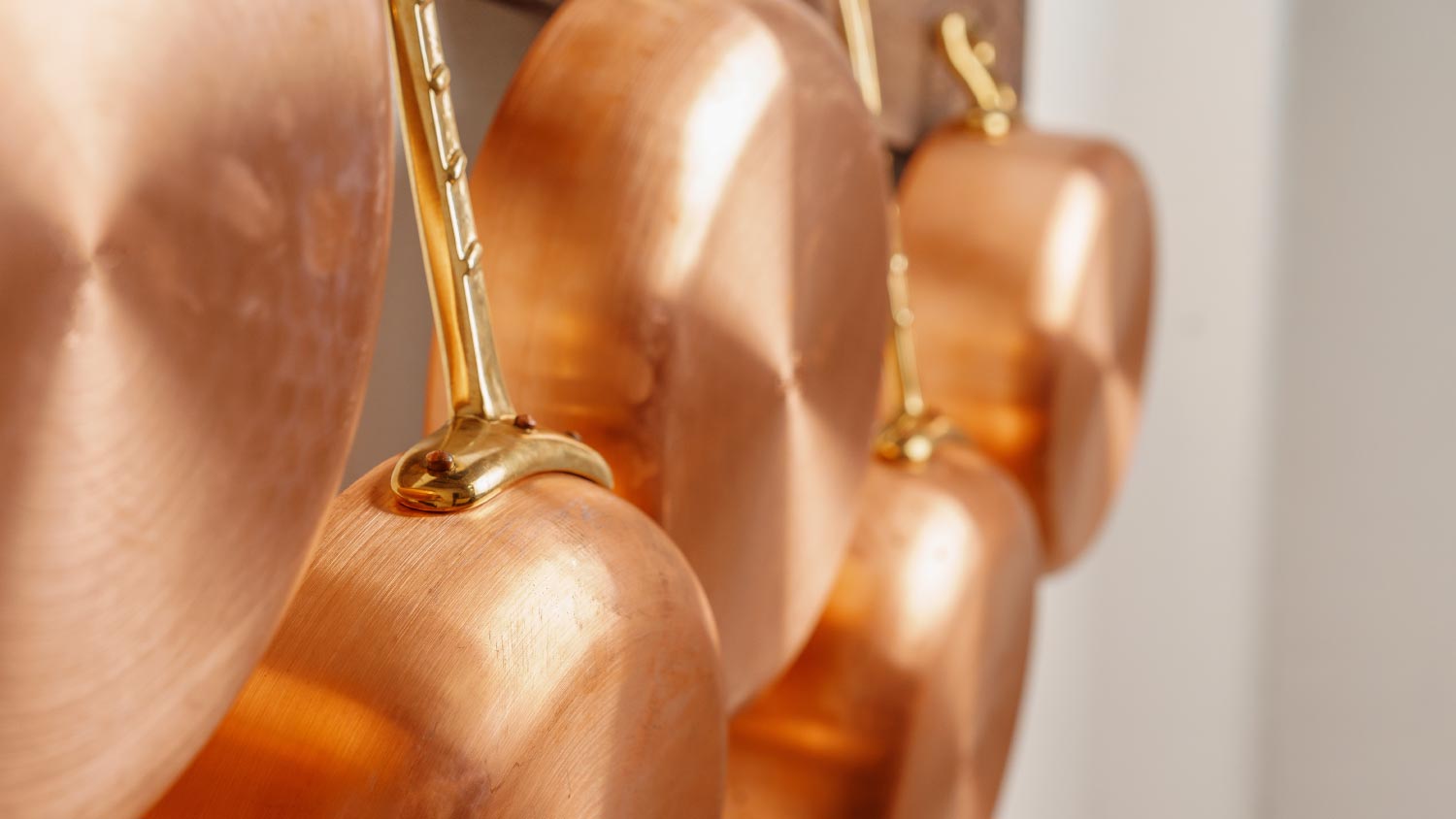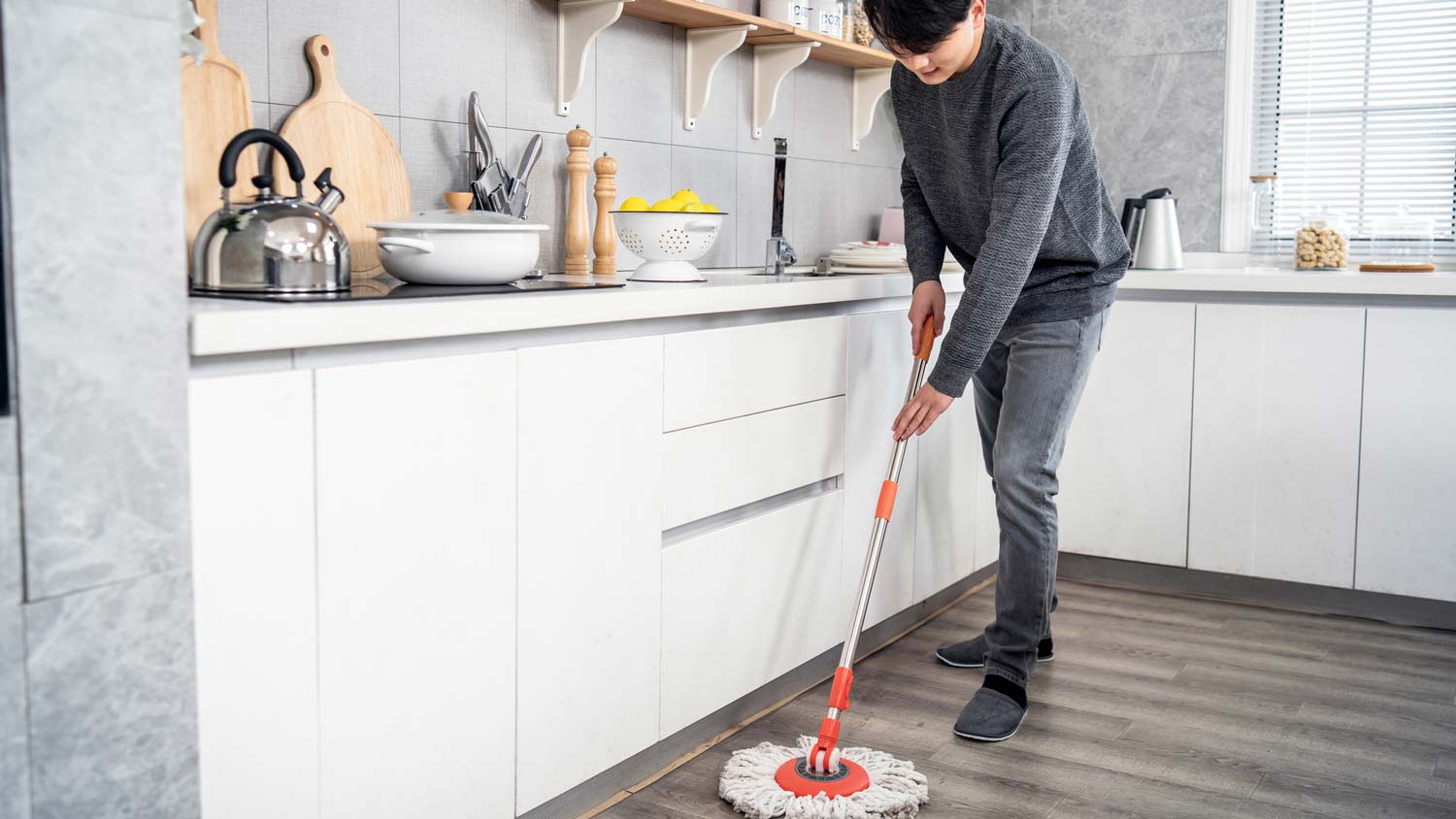How to Clean Copper and Keep It in Pristine Condition
Restore your heirlooms to their former glory


Copper kitchen items and decor add a vintage feel to any room, and your favorite frying pan or tea kettle may be made of copper since this metal is so great at conducting heat. But unlike your modern pots and pans, you can’t just throw a copper pot in the dishwasher to clean it. Instead, you’ll need to know how to clean copper by hand to prevent tarnishing and restore its former shine. From kitchen utensils to appliances, here’s how to polish copper and keep it clean.
Why Does Copper Tarnish?
Copper naturally oxidizes when exposed to oxygen, so there’s no real way to prevent tarnishing from happening. Over time, copper can also become tarnished or dirty from the oils in your hands, dust in the air, or other dirt and debris that come into contact with copper. When it comes to copper cookware, sinks, or your favorite mule mugs, even the food or liquids you add can have a reaction with the material and corrode it.
How Much Does It Cost to Clean Copper?

Cleaning copper is actually easy and inexpensive to DIY. You’ll likely just need to rummage around in the fridge or pantry for some items that can help react with the copper to break down any oxidation or corrosion. Even if you don’t have things like lemons, vinegar, or salt on hand, you’ll spend less than $25 total on the ingredients you need to polish copper.
How to Clean Copper

There are many ways to clean copper items. If your kitchen is fully stocked, you’ll find many of the cleaning agents you need in your fridge, pantry, or even the fruit bowl to make a homemade copper cleaner.
Use Lemons and Salt to Make a Homemade Copper Cleaner
Use lemons, limes, or another citrus with some basic table salt as a gentle way to scrub the tarnish off of copper.
Cut the citrus in half.
Sprinkle salt onto one of the cut halves.
Rub the cut half of the salted citrus over the surface of the copper for about 10 minutes.
Use a clean, dry cloth to wipe away any tarnish and dry the copper.
Try Vinegar and Salt
No lemons on hand? No problem. Just break out another acidic ingredient: vinegar.
Wiping the Copper With a Vinegar-Soaked Cloth
Pour salt over the copper surface.
Soak a cloth in vinegar.
Rub the cloth over the salted surface of the copper.
Rinse the copper item in water.
Use a dry cloth to wipe the item dry.
Boiling in Vinegar and Water
For heavily tarnished items, you may need to do a more in-depth cleaning by dropping the copper item in a boiling mixture of water, vinegar, and salt.
Combine 3 to 5 cups of water, 1 cup of vinegar, and 1 to 2 tablespoons of salt in a large pot.
Add the copper item into the pot.
Bring the water to a boil, stirring to dissolve the salt.
Let the copper item sit in the boiling water mixture until the tarnish begins to come off.
Remove the copper item carefully with tongs or another tool to avoid burns.
Scrub any remaining tarnish off with a cloth.
Dry the copper item thoroughly with a clean cloth.
Combat Copper Tarnish With Lemon and Cornstarch
Cornstarch and lemon juice combine to make a powerful cleaning paste that will clean your copper to look new again.
Mix 1 part salt and 1 part non-iodized cornstarch in a bowl.
Squeeze in just enough lemon juice to make a paste.
Dip a cleaning cloth into the paste.
Rub the cloth over the copper surface, buffing away tarnish.
Rinse the copper surface.
Use a clean, dry cloth to clean the copper.
Cleaning Copper With Ketchup or Tomato Paste
Like citrus or vinegar, tomato-based products have just enough acidity to remove tarnish from oxidation on copper. You can use tomato paste or ketchup to clean your copper items.
Rub tomato paste or ketchup over the copper surface.
Let the tomato-based product sit on the copper for about five minutes.
Wash the copper with liquid dish soap and warm water.
Use a cloth to dry the copper thoroughly.
Shine Copper With Vinegar and Flour
Once you’ve removed the oxidation and corrosion from copper, you may want to give it a little extra shine by polishing the surface. To make a copper polishing paste, you can use vinegar as a cleaning agent, along with a little table salt and some all-purpose flour.
Combine 1 part salt and 1 part all-purpose flour in a bowl.
Pour in a bit of white vinegar, just enough to make a paste.
Dip a microfiber cloth into the paste, then buff it into the surface of the copper.
Rinse the copper with water.
Use a clean cloth to dry the copper item.
Tips for Keeping Copper Clean

Copper items can last a lifetime with proper care, but you’ll need to keep up with a cleaning and polishing routine to prevent a heavy patina from developing.
1. Hand-Wash Only
While tossing items in the dishwasher is convenient, leave copper kitchenware with your chef’s knives and delicate crystal glasses for handwashing.
2. Clean Copper Regularly
To keep your copper looking its best, plan to deep clean it with methods like lemon and salt or vinegar about every six months. This scheduled cleaning minimizes tarnish and corrosion over the years, so your prized copper kitchenware or decor can be passed down to your kids.
3. Shine as Needed
Any time your copper goods look a little lackluster, whip up a homemade polisher with salt, flour, and vinegar. You can also find copper polishing products at retailers for $5 to $30.
4. Always Dry Copper With a Cloth
Moisture can cause copper to develop blue-green corrosion, so make sure you have a clean, dry cloth ready to dry off your copper items after washing or rinsing them. Make sure to get the cloth inside and out of the copper pots, pans, cups, kettles, or vases to dry off every nook and cranny.
5. Skip Abrasive Cleaning Tools
Abrasive cleaning tools like steel wool or scrub brushes are better reserved for scrubbing set stains on stainless steel baking sheets. Copper is delicate, and harsh tools or cleaners, like bleach, may damage this metal.
6. Oil Copper After Cleaning
Add just a light layer of mineral oil, olive oil, or even baby oil over copper surfaces like sinks after cleaning, drying, and polishing them. This step helps protect the vulnerable surface from exposure to oxygen, which speeds up tarnishing.
DIY vs. Hiring a Pro to Clean Tarnished Copper
While you can certainly handle polishing copper tea kettles and flower pots, larger copper items like copper kitchen sinks, fridges, and wall fixtures may be a bigger job. The solutions above are definitely still applicable, but hiring a local cleaning pro to take these jobs on, along with other general cleaning tasks, may be worth your while.
Plus, once they bring these copper items back to their former glory, they can help you maintain them so you won’t have to worry about tarnished copper again.
Frequently Asked Questions
You can clean copper whenever you notice the material starting to tarnish or when you acquire a vintage find or heirloom keepsake that has years of corrosion. Once you clean and polish your copper items, make a plan to give them another deep clean about every six months to minimize signs of oxidation.
Toothpaste can polish copper and even silverware, but you may need to use a lot of your tube of toothpaste depending on how many items you want to polish. A more cost-effective solution for polishing is to make a paste with flour, salt, and vinegar.
While some people want their copper to look as good as new, others appreciate the patina with copper that has lived a long life. You can use ammonia, vinegar, and table salt to clean copper and even encourage it to develop a patina. When it reaches the patination level you prefer, you can preserve that unique color by applying a lacquer or varnish over the copper item.





- House Cleaning Services
- Housekeeping Services
- Tile Grout Cleaners
- Move Out Cleaners
- Deck Cleaning Services
- Same Day House Cleaning
- Ultrasonic Cleaning
- Apartment Cleaners
- Vinyl Siding Cleaning
- Mattress Cleaners
- Kitchen Hood Cleaning
- Emergency Cleaning Services
- Housekeeper Agencies
- Residential Cleaners
- Cleaning Crews
- Couch Cleaning
- Garage Cleaning Services
- Odor Removal Services
- Commercial Cleaning Services
- What’s the Difference Between Copper Gutters and Aluminum Gutters?
- Copper Pipes vs. PVC Pipes: What Are the Key Differences?
- Do Copper Pipes Freeze and Can You Prevent It?
- Aluminum Wiring vs. Copper Wiring: How to Choose
- The 4 Types of Copper Pipes You Might Encounter in Construction
- 7 Ways to Fix a Copper Pipe Leak: Temporary and Long-Term Solutions
- How to Take Care of Your Pots and Pans, No Matter the Material
- Don't Be a Victim of These 3 Contractor Scams
- The 5 Most Common Types of Metal Siding for Your Home
- 11 Cleaning Hacks Everyone Should Know











